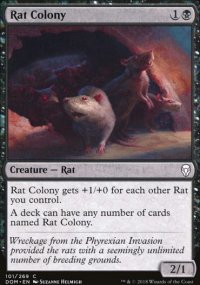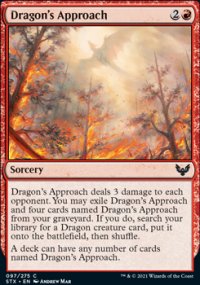|

MV anecdotes
| Revenir à la page 74 |  |
1758/4870 |  |
Relentless Rats est la toute première carte imprimée mentionnant explicitement dans son texte que son nombre d'exemplaires n'est pas limité dans un deck. Elle s'inspire de la carte Plague Rats, qui, d'après une légende urbaine de Magic (voir cette anecdote), aurait été jouée à l'origine dans des decks en contenant un nombre non limité à 4 exemplaires.
Elle sera suivie ensuite par Shadowborn Apostle, Rat Colony, Persistent Petitioners, Dragon's Approach, Slime Against Humanity, Templar Knight, Hare Apparent et Tempest Hawk.
La carte Seven Dwarves (respectivement Nazgûl) présente quant à elle une variante, puisque son nombre d'exemplaires n'est pas illimité, mais limité à 7 (respectivement 9) au lieu de 4, en cohérence avec son flavor (voir cette anecdote).
Search ~ Texte : "A deck can have"
Elle sera suivie ensuite par Shadowborn Apostle, Rat Colony, Persistent Petitioners, Dragon's Approach, Slime Against Humanity, Templar Knight, Hare Apparent et Tempest Hawk.
La carte Seven Dwarves (respectivement Nazgûl) présente quant à elle une variante, puisque son nombre d'exemplaires n'est pas illimité, mais limité à 7 (respectivement 9) au lieu de 4, en cohérence avec son flavor (voir cette anecdote).
Search ~ Texte : "A deck can have"
Source 1 a écrit :
R&D tried numerous times to recapture the feel of Plague Rats, usually choosing to make the creatures bigger based on all your Rats.
Then during Fifth Dawn, we tried a new approach. What if the card just let you include as many copies as you wanted to play? [...] Once we had the "a deck may have any number" technology, we used it, although sparingly, on other cards. In the beginning, it was just used in black, although not always on Rats.
Ravnica Allegiance introduced the ability to blue, and Throne of Eldraine and Strixhaven would give it to red. The Council of Colors have talked about this. We've determined that, as long as the card fits into its color, any color can have access to "a deck may have any number" text.
In Throne of Eldraine, I wanted to capture the flavor of the seven dwarves. My original plan was to have exactly seven Dwarf cards in the set, but it took up too much space and was a little too much of a constraint on card concepting. My solution was to make one card called Seven Dwarves and then make a variant of the Relentless Rats template. Instead of letting you have any number, the card lets you have up to a specific number. In this case, seven.
We used that technology again in The Lord of the Rings: Tales of Middle-earth. We knew we wanted to have Nazgûl. They're one of the big villains in the story, but like the seven dwarves, we didn't have space to do nine. Luckily, we'd solved the problem already. Nazgûl uses the Seven Dwarves technology and becomes the first card where you can have up to nine copies in your deck.
Then during Fifth Dawn, we tried a new approach. What if the card just let you include as many copies as you wanted to play? [...] Once we had the "a deck may have any number" technology, we used it, although sparingly, on other cards. In the beginning, it was just used in black, although not always on Rats.
Ravnica Allegiance introduced the ability to blue, and Throne of Eldraine and Strixhaven would give it to red. The Council of Colors have talked about this. We've determined that, as long as the card fits into its color, any color can have access to "a deck may have any number" text.
In Throne of Eldraine, I wanted to capture the flavor of the seven dwarves. My original plan was to have exactly seven Dwarf cards in the set, but it took up too much space and was a little too much of a constraint on card concepting. My solution was to make one card called Seven Dwarves and then make a variant of the Relentless Rats template. Instead of letting you have any number, the card lets you have up to a specific number. In this case, seven.
We used that technology again in The Lord of the Rings: Tales of Middle-earth. We knew we wanted to have Nazgûl. They're one of the big villains in the story, but like the seven dwarves, we didn't have space to do nine. Luckily, we'd solved the problem already. Nazgûl uses the Seven Dwarves technology and becomes the first card where you can have up to nine copies in your deck.
Source 2 a écrit :
To appreciate the story of [Hare Apparent]'s design, we'll also begin this tale all the way back during Alpha design in August of 1993.
When Magic first came out, there was only one deck-construction rule: your deck had to be a minimum of 40 cards. Yes, 40 cards. Constructed decks being 60 cards wouldn't happen until Wizards formed the DCI (Duelists' Convocation International), and thus sanctioned play, in early 1994. The 40-card limit was kept for Limited play.
The lack of rules meant there weren't any card restrictions. A deck could have as many copies of a card as it wanted. Plague Rats was clearly designed with this in mind. One of the popular early decks had only three unique cards in it: Swamp , Dark Ritual , and Plague Rats.
Inspired by the popularity of Plague Rats , R&D kept making more Rats, and many of them got more powerful the more Rats you controlled.
During Fifth Dawn design, we decided it was time to redo Plague Rats as originally intended. We made three small changes. First, this card would be a 2/2 instead of a 1/1. Second, it'd cost 1BB instead of 2B. Third, we added "A deck can have any number of cards named CARDNAME." This would allow you to play as many as you wanted regardless of the restriction of the format you were playing.
R&D nicknamed the ability "relentless" after Relentless Rats . We used it sparingly. [...]
When Magic first came out, there was only one deck-construction rule: your deck had to be a minimum of 40 cards. Yes, 40 cards. Constructed decks being 60 cards wouldn't happen until Wizards formed the DCI (Duelists' Convocation International), and thus sanctioned play, in early 1994. The 40-card limit was kept for Limited play.
The lack of rules meant there weren't any card restrictions. A deck could have as many copies of a card as it wanted. Plague Rats was clearly designed with this in mind. One of the popular early decks had only three unique cards in it: Swamp , Dark Ritual , and Plague Rats.
Inspired by the popularity of Plague Rats , R&D kept making more Rats, and many of them got more powerful the more Rats you controlled.
During Fifth Dawn design, we decided it was time to redo Plague Rats as originally intended. We made three small changes. First, this card would be a 2/2 instead of a 1/1. Second, it'd cost 1BB instead of 2B. Third, we added "A deck can have any number of cards named CARDNAME." This would allow you to play as many as you wanted regardless of the restriction of the format you were playing.
R&D nicknamed the ability "relentless" after Relentless Rats . We used it sparingly. [...]
Cette anecdote vous a été proposée par bulle.
Vous voyez une faute, une erreur, un oubli dans cette anecdote ? cliquez ici pour nous en informer.

















